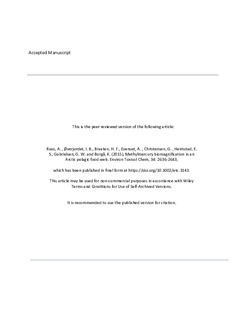| dc.contributor.author | Ruus, Anders | |
| dc.contributor.author | Øverjordet, Ida Beathe | |
| dc.contributor.author | Braaten, Hans Fredrik Veiteberg | |
| dc.contributor.author | Evenset, Anita | |
| dc.contributor.author | Christensen, Guttorm N. | |
| dc.contributor.author | Heimstad, Eldbjørg Sofie | |
| dc.contributor.author | Gabrielsen, Geir W. | |
| dc.contributor.author | Borgå, Katrine | |
| dc.date.accessioned | 2018-10-08T08:05:34Z | |
| dc.date.available | 2018-10-08T08:05:34Z | |
| dc.date.created | 2015-12-22T19:21:54Z | |
| dc.date.issued | 2015 | |
| dc.identifier.citation | Environmental Toxicology and Chemistry. 2015, 34 (11), 2636-2643. | nb_NO |
| dc.identifier.issn | 0730-7268 | |
| dc.identifier.uri | http://hdl.handle.net/11250/2566765 | |
| dc.description.abstract | Mercury (Hg) is a toxic element that enters the biosphere from natural and anthropogenic sources, and emitted gaseous Hg enters the Arctic from lower latitudes by long-range transport. In aquatic systems, anoxic conditions favor the bacterial transformation of inorganic Hg to methylmercury (MeHg), which has a greater potential for bioaccumulation than inorganic Hg and is the most toxic form of Hg. The main objective of the present study was to quantify the biomagnification of MeHg in a marine pelagic food web, comprising species of zooplankton, fish, and seabirds, from the Kongsfjorden system (Svalbard, Norway), by use of trophic magnification factors. As expected, tissue concentrations of MeHg increased with increasing trophic level in the food web, though at greater rates than observed in several earlier studies, especially at lower latitudes. There was strong correlation between MeHg and total Hg concentrations through the food web as a whole. The concentration of MeHg in kittiwake decreased from May to October, contributing to seasonal differences in trophic magnification factors. The ecology and physiology of the species comprising the food web in question may have a large influence on the magnitude of the biomagnification. A significant linear relationship was also observed between concentrations of selenium and total Hg in birds but not in zooplankton, suggesting the importance of selenium in Hg detoxification for individuals with high Hg concentrations. Environ Toxicol Chem 2015;34:2636–2643. © 2015 SETAC | nb_NO |
| dc.language.iso | eng | nb_NO |
| dc.publisher | Wiley | nb_NO |
| dc.title | Methylmercury biomagnification in an Arctic pelagic food web | nb_NO |
| dc.title.alternative | Methylmercury biomagnification in an Arctic pelagic food web | nb_NO |
| dc.type | Journal article | nb_NO |
| dc.type | Peer reviewed | nb_NO |
| dc.description.version | acceptedVersion | nb_NO |
| dc.source.pagenumber | 2636-2643 | nb_NO |
| dc.source.volume | 34 | nb_NO |
| dc.source.journal | Environmental Toxicology and Chemistry | nb_NO |
| dc.source.issue | 11 | nb_NO |
| dc.identifier.doi | 10.1002/etc.3143 | |
| dc.identifier.cristin | 1303989 | |
| dc.relation.project | Framsenteret: Hazardous Substances—Effects on Ecosystem and Health | nb_NO |
| dc.relation.project | Norges forskningsråd: 234388 | nb_NO |
| dc.relation.project | Norges forskningsråd: 176073 | nb_NO |
| dc.description.localcode | This is the peer reviewed version of the following article: [Methylmercury biomagnification in an Arctic pelagic food web], which has been published in final form at [https://doi.org/10.1002/etc.3143]. This article may be used for non-commercial purposes in accordance with Wiley Terms and Conditions for Self-Archiving. | nb_NO |
| cristin.unitcode | 194,66,10,0 | |
| cristin.unitname | Institutt for biologi | |
| cristin.ispublished | true | |
| cristin.fulltext | postprint | |
| cristin.qualitycode | 2 | |
